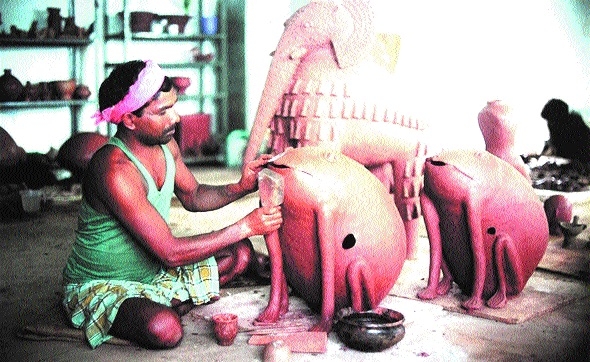Ritual of Mendhka Bihav in IGRMS expo series
Date :09-Jul-2021

Artist Mahadev Sahana making a frog sculpture at IGRMS.
Staff Reporter :
Under the fifty-six series of its online exhibition by Indira Gandhi Rashtriya Manav Sangrahalaya (IGRMS), on Thursday, presented the Ritual of Mendhka Bihav situated in the Mythological Trail Open Air Exhibition of Manav Sangrahalaya has been presented online with its basic information and photographs and videos. About this exhibition, Dr Praveen Kumar Mishra, Director of IGRMS, said that with the arrival of monsoon the earth blossoms like a flower. There is greenery all around, as if the earth is clad with a green blanket. Since ancient times, there has been a tradition of worshipping the gods and goddesses for good rain at the right time.
For this various kinds of offerings were made, musical instruments were played and songs were sung to please the God. Even today, many unique practices regarding monsoon are prevalent in different parts of the country. Whether it is rain forecast by burying pots in the ground in Seraikela of Jharkhand or leaving the villages and spending the day in the forest in Telangana, or in Karnataka there was a practice of hanging in the air with thorns. Or the practice of bathing in mud or to invoke rain by playing Tumba in Chhattisgarh. One such practice is the marriage of mendhak and mendhaki (frog couple). In many states like Assam, Rajasthan, Madhya Pradesh, Karnataka and Chhattisgarh, there has been a tradition of getting the frog married in the absence of rain. In Bastar area of Chhattisgarh the marriage ritual of Mendhak and Mendhaki is celebrated with festivities.
Whenever the first half of the monsoon go dry the villagers meet at the shrine of Goddess Jimidarin Mata to take her permission to conduct the ritual frog marriage. Jimidarin Mata is the leading Goddess among all the guardian deities of Bastar, and is supposed to protect the village from any evil, especially diseases. She is visualised standing with flowers and rice sheaves in her hands. The whole village contributes in cash and kind towards it. A person from Marar or Panara caste is given the job of making the marriage crown from palm leaf. On the appointed day the Gayeta or the priest brings two frogs from the nearby stream, young girls and boys fetch a branch of the Mahua tree and fix it in the marriage pavilion. The crowned frog couple are then placed under the branch and anointed with turmeric and oil. A married woman carrying the pitcher takes seven rounds of the couple before the knot is tied. The whole village then feasts and makes merry. Thereafter the frog couple is taken back to their original abode.
It is believed that the happy couple will croak and this will lure the clouds to their parched fields and on the third day of the marriage the rain occurs. About the Mendhka, P Anuradha, Museum Associate said that–such interesting ritual is visualised in the form of an exhibition and depicted in a terracotta mural with two terracotta frogs sculptures placed facing each other. The terracotta artist Sahadev Rana from Kondagaon, Bastar region of Chhattisgarh has beautifully created the mural and sculpture. He is a versatile potter. His art works the beautifully ornamented elephants and horses adorn almost all the art centres and museums related to folk culture in India. He is also a treasurer of stories, myths and folklores. He has a long association with IGRMS for creating some rituals and myths of Adivasi gods and goddesses of Bastar for the open air exhibition Mythological Trail.